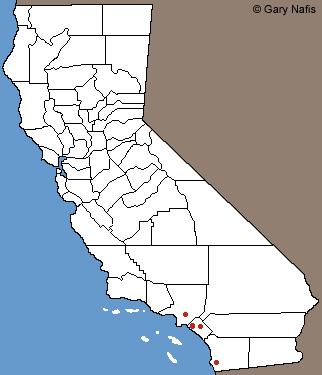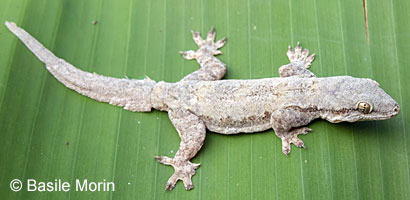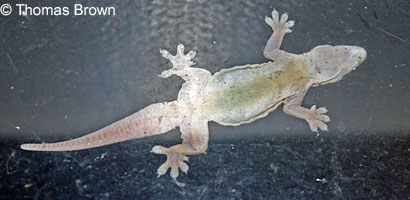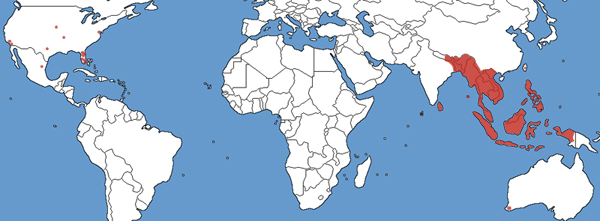Range in Cali Red Red: Some general locations where this
gecko may be established
|
This species has been introduced into California. It is not a native species.
|
 |
 |
Adult, Don Det, Si Phan Don, Laos © Basile Morin
(cropped thumbnail - click photo to see original) |
Adult, Laos © Basile Morin
(cropped thumbnail - click photo to see original) |
 |
 |
| Adult, Orange County © William Flaxington |
Underside of adult on glass, showing webbed-toes and fringes,
Sa Kaeo, Thailand © Thomas Brown
(cropped thumbnail - click photo to see original) |
| |
|
|
|
|
Description |
|
| Size |
Adults are about 2.7 inches (69mm) long from snout to vent. The tail is about equal to the body length.
They are also reported to grow to about 6 inches (15 cm) in total length, with thee tail about half of the length.
|
| Appearance |
A small species with a short stout body, a large head with a long snout, well-developed limbs, and a broad flat tail with a serrated edge.
The toes have adhesive pads for climbing and the toes are partially-webbed.
Eyes with vertically elliptical pupils and no moveable eyelids.
Color is gray-brown, cream, tan, or gray.
Typically there is a dark line from behind the eye that continues in a dark stripe on the lateral edge of the body.
Changes color from a darker color with bark-like markings in the dark phase to an almost patternless cream color in the light phase at night.
The body is covered above with uniform small granular scales, with the largest scales on the snout.
The underside is cream to yellow-colored and is covered with small plates.
The body and rear legs are edged with skin flanges. "When the lateral flanges are spread outward, this little lizard casts little if any shadow, hence is nearly invisible against many natural backgrounds." (Bartlett & Bartlett).
Young have more well-defined bands around the tail.
|
| Life History and Behaviors |
Nocturnal.
Arboreal. An excellent climber, able to climb vertical walls and walk on ceilings.
Often observed on the walls of buildings at night where it is attracted to external lights and feeds on the invertebrates attracted to the lights.
Makes clicking sounds to communicate with other geckos. Squeaks when captured.
Frequently found in the pet trade.
"When threatened at elevated sites, can jump away from walls or other surfaces, holding out digits and limbs to expand webbing and skin folds, which allows controlled parachuting away from danger." (Hansen and Shedd).
|
| Diet |
| Eats a variety of invertebrates. |
| Reproduction and Young |
Oviparous.
Breeds all year long in its native range in the tropics.
Females lay pairs of eggs in cracks and crevices and other protected locations above the ground.
|
| Habitat |
Inhabits forested areas, agricultural areas, and human structures in its native range.
In California, found on buildings in urban areas.
|
| Range |
Native Distribution
Found naturally in southeastern and southern Asia, including Bangladesh, India, Nepal, Bhutan, China, Tibet, Taiwan, Sri Lanka, Thailand, Cambodia, Malaysia, Myanmar, Vietnam, Indonesia, and the Phillipines.
Distribution in California
According to Hansen and Shedd (California Amphibians and Reptiles, 2025 p. 144) the species was: "First observed in CA adjacent to a reptile-import business in the late 1980s; that population appears to have died out following a change in the commercial landscaping and sprinkler system."
Flat-tailed House Geckos have been recorded from several locations in coastal southern California, including:
San Diego County
- A breeding population has been reported at the San Diego Zoo in Balboa Park, San Diego County. There are several iNaturalist records for the species there, most around the reptile house, with a photo and a comment from Greg Pauly, Associate Curator of Herpetology at the Natural History Museum of Los Angeles County, who states: "There is a known population of this species established at the Reptile House." There is also a specimen record in the NHMLA from the Reptile House.
Orange County
- There is a record for one specimen collected in Santa Ana in 2016 in the Natural History Museum of Los Angeles County.
There are also several specimens in the NHMLA collection from Orange County with no specific location given, and iNaturalist observations from Orange County.
Los Angeles County
- There are iNaturalist observations from Los Angeles and a specimen in the HNMLA collection with no specific location given.
There are several observations listed in the H.E.R.P. database from Orange and San Diego Counties.
|
 |
| Red: approximate native range and some other locations where Flat-tailed House Geckos have been observed and poosbily established. |
| Taxonomic Notes |
"Native to southeastern Asia. It was introduced via the pet trade during the 1980s and is established in Clearwater, Pinellas County, Florida (Meshaka and Lewis, 1994, Herpetological Review 25: 127) and has since been found in Alachua, Broward, Lee, and Miami-Dade counties (Krysko, 2019, Hemidactylus platyurus. Pages 332–333 in Krysko et al. (Editors) Amphibians and Reptiles of Florida. University Press of Florida, Gainesville, Florida). This species was transferred from Cosymbotus (Carranza and Arnold (2006, Molecular Phylogenetics
and Evolution 38: 531–545)."
(Nicholson, K. E. (ed.). 2025 SSAR Scientific and Standard English Names List)
|
| Conservation Issues (Conservation Status) |
| It is not understood what effect this non-native species might have on native species. |
|
Taxonomy |
| Family |
Gekkonidae |
Geckos |
Gray, 1825 |
| Genus |
Hemidactylus |
House Geckos |
Gray, 1825 |
Species
|
platyurus |
Flat-tailed House Gecko |
(Schneider, 1797) |
|
Schneider, 1797
|
Meaning of the Scientific Name
|
Hemidactylus - Hemidactylus - Greek - hemi = half + Greek - daktylion = fusion of digits
Refers to the split lamella of the fingers and toes in this genus, i.e. the “half” (hemi) lamella under the fingers (Greek 'dactylos')
platyurus - Greek - "platys" - flat and "oura" - tail = "flat-tailed."
|
|
Asian Flat-tailed House Gecko
Flat-tailed Gecko
Asian House Gecko
Frilled House Gecko
Hemidactylus platyurus - Asian Flat-tailed House Gecko (2025 SSAR Names List)
Cosymbotus platyurus - Asian Flat-tailed Gecko (Bartlett & Bartlett, 2009)
|
Related or Similar California Herps
|
Peninsular Leaf-toed Gecko - Phyllodactylus nocticolus
Non-native geckos in California
Rough-tailed Gecko - Cyrtopodion scabrum
Common House Gecko - Hemidactylus frenatus
Indo-Pacific Gecko - Hemidactylus garnotii
Tropical House Gecko - Hemidactylus mabouia
Flat-tailed House Gecko - Hemidactylus platyurus
Mediterranean Gecko - Hemidactylus turcicus
Yellow Fan-Fingered Gecko - Ptyodactylus hasselquistii
Ringed Wall Gecko - Tarentola annularis
Moorish Gecko - Tarentola mauritanica
|
More Information and References
|
Hansen, Robert W. and Shedd, Jackson D. California Amphibians and Reptiles. (Princeton Field Guides.) Princeton University Press, 2025.
Bartlett, R. D. & Patricia P. Bartlett. Guide and Reference to the Amphibians of Western North America (North of Mexico) and Hawaii. University Press of Florida, 2009.
Nicholson, K. E. (ed.). 2025. Scientific and Standard English Names of Amphibians and Reptiles of North America North of Mexico, with Comments Regarding Confidence in Our Understanding. Ninth Edition. Society for the Study of Amphibians and Reptiles. [SSAR] 87pp.
More photos and information online:
Wickipedia
The Reptile Database
iNaturalist
GeckoWeb
Ecology Asia
Wild Herps
|
|
|
The following conservation status listings for this animal are taken from the July 2025 State of California Special Animals List and the July 2025 Federally Listed Endangered and Threatened Animals of California list (unless indicated otherwise below.) Both lists are produced by multiple agencies every year, and sometimes more than once per year, so the conservation status listing information found below might not be from the most recent lists, but they don't change a great deal from year to year.. To make sure you are seeing the most recent listings, go to this California Department of Fish and Wildlife web page where you can search for and download both lists:
https://www.wildlife.ca.gov/Data/CNDDB/Plants-and-Animals.
A detailed explanation of the meaning of the status listing symbols can be found at the beginning of the two lists. For quick reference, I have included them on my Special Status Information page.
If no status is listed here, the animal is not included on either list. This most likely indicates that there are no serious conservation concerns for the animal. To find out more about an animal's status you can also go to the NatureServe and IUCN websites to check their rankings.
Check the current California Department of Fish and Wildlife sport fishing regulations to find out if this animal can be legally pursued and handled or collected with possession of a current fishing license. You can also look at the summary of the sport fishing regulations as they apply only to reptiles and amphibians that has been made for this website.
|
| Organization |
Status Listing |
Notes |
| NatureServe Global Ranking |
|
|
| NatureServe State Ranking |
|
|
| U.S. Endangered Species Act (ESA) |
None |
|
| California Endangered Species Act (CESA) |
None |
|
| California Department of Fish and Wildlife |
None |
|
| Bureau of Land Management |
None |
|
| USDA Forest Service |
None |
|
| IUCN |
|
|
|
|







